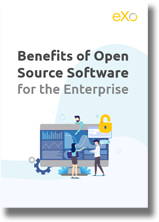- Anne-Sophie Duport
- November 7, 2024
Could Open Source Be the Right Solution to Cut IT Costs?
As Europe is facing an ongoing inflation, in particular in the energy sector, organizations are urgently seeking ways to reduce expenses. Open-source software presents a strategic approach to cutting IT costs, especially for public sectors aiming for economic efficiency.
Open-source solutions are increasingly popular as they allow organizations to modernize their IT infrastructure while achieving substantial savings and avoiding dependence on proprietary software. According to GitNux’s 2024 report, open-source software could help organizations worldwide save up to $60 billion annually.

Content
Here’s how open-source can help optimize IT budgets.
1. Savings on Licensing Costs
Open-source software cuts out licensing fees, saving billions annually. This advantage benefits organizations using open-source tools across various IT functions, from infrastructure to databases. While support for open-source tools often comes at an additional cost, it remains optional and usually more affordable.
Although open-source deployment and maintenance require specific expertise, even these costs are typically far lower than proprietary software expenses. Open-source tools also allow for custom configurations, eliminating unused components included in proprietary packages.
2. Freedom from Vendor Lock-In
Open-source eliminates reliance on single-vendor systems, making organizations free from the limitations of proprietary platforms. With access to source code, organizations can adjust their IT needs flexibly and affordably, even in fluctuating conditions.
While proprietary solutions focus on seamless integration from one provider, open-source encourages modularity, allowing organizations to build customized tech stacks.
A recent GitNux report indicates 92% of leaders see open-source software as equal to or better than proprietary options in terms of performance.
3. Enhanced Security and Transparency
Open-source is known for its security benefits, often underestimated. Unlike proprietary solutions, open-source code is regularly reviewed by the community, ensuring rapid bug fixes and ongoing security enhancements. The Linux Foundation reports that about 68% of IT leaders consider open-source more secure due to its transparency.
Moreover, organizations can modify code for tailored security needs, reducing risk management and compliance costs. In Europe, initiatives like “public money, public code” are gaining traction to enhance transparency in public services and reduce expenses.
4. Fostering Innovation
Open-source software’s accessibility accelerates adaptability and innovation, with frequent updates and contributions from a proactive global community of developers. According to GitNux, 86% of companies say open-source boosts innovation through faster integration of new features.
The Linux Foundation also emphasizes that open-source promotes continuous innovation, facilitated by contributions from external developers and partners, keeping organizations agile and competitive.
5. Resource Optimization and Flexibility
Open-source solutions provide high flexibility, supporting various infrastructures from cloud to on-premise environments. With scalable and portable designs, open-source allows for seamless migration and hardware reusability, avoiding vendor lock-in.
Many businesses now leverage open-source for adaptable and sustainable infrastructure renewal, as 60% of companies report in the 2024 GitNux survey.
6. Skill Sovereignty
Beyond financial and functional considerations, open-source strengthens in-house expertise. Proprietary systems restrict organizations to using pre-packaged solutions, whereas open-source encourages developing internal technical skills.
Investing in open-source also brings greater autonomy in IT management, reducing dependency on third-party vendors.
7. Case Study: Occitanie Region
The Occitanie region has cut its dependency on tech giants by switching from Office 365 to eXo Platform for collaboration, aligning with its goals of digital sovereignty, security, and cost management. This shift reduced their software expenses by 75%. eXo Platform’s secure SaaS model supports teamwork and document sharing, earning user approval for usability.
Occitanie continues to adopt open-source alternatives to lower licensing costs for services like email, enhancing digital sovereignty.

FREE WHITE PAPER
Open Source Alternative to Microsoft 365
Empower your organization with eXo Platform to break free from Microsoft dependencies and enhance collaboration with innovative solutions
8. Selecting the Right Open-Source Alternatives
Open-source solutions have diversified beyond technical layers to prioritize user experience. Below is a table of open-source alternatives to popular proprietary software based on IT needs.
Uses | Open-source alternatives | Proprietary solutions |
ERP and CRM | Odoo, Dolibarr | SAP, Microsoft Dynamics |
Full digital workplace | eXo Platform | Microsoft 365, Google workspace |
Zimbra, Bluemind | Outlook, Gmail | |
File system & document storage | Alfresco, Nuxeo, Nextcloud | OneDrive, Sharepoint, Google, Dropbox |
Social network | eXo Platform, Opensocial, Humhub | Viva engage, Facebook / Workvivo |
Team communication | Mattermost | Slack, Teams
|
Video conferencing | Jitsi | Zoom, Teams |
Knowledge sharing and organization | Mediawiki, XWiki | Confluence |
Office suite | OnlyOffice, Collabora | Microsoft Office, Google |
Portal (CMS) | eXo Platform, Drupal, WordPress, Liferay |
|
Operating systems | Linux, RedHat | Windows, MacOS |
Open-source technology is deeply integrated into our everyday lives, powering supercomputers, smartphones, and many websites. For instance, 85% of smartphones operate on an open-source kernel (Android), and 41.4% of websites use WordPress (GitNux 2024 report).
With quick adoption and a growing market—valued at $21.7 billion in 2021 and projected to exceed $66 billion by 2026—open-source is becoming a powerful innovation driver. Organizations aiming to remain competitive in today’s demanding landscape should consider open-source as a strategic key for their IT infrastructure.

FREE WHITE PAPER
for the Enterprise
- Tags: Open source, Future of work, Tips & Tricks
Articles associés
- All
- eXo
- Digital workplace
- Employee engagement
- Open source
- Future of work
- Internal communication
- Collaboration
- News
- intranet
- workplace
- Knowledge management
- Employee experience
- Employee productivity
- onboarding
- Employee recognition
- Change management
- Cartoon
- Digital transformation
- Infographic
- Remote work
- Industry trends
- Product News
- Thought leadership
- Tips & Tricks
- Tutorial
- Uncategorized



